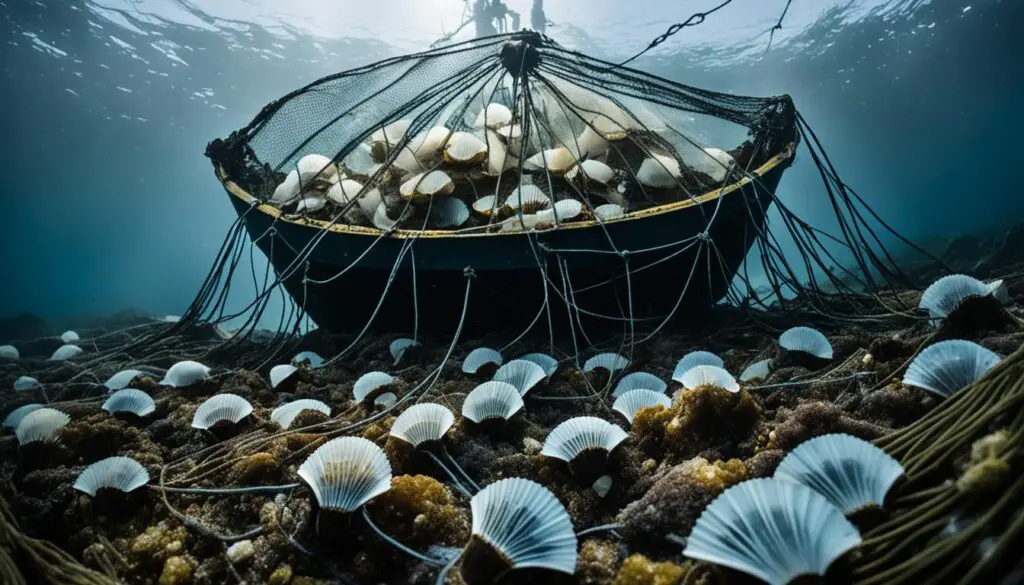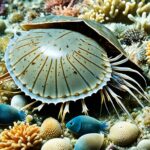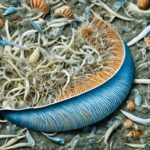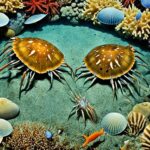Have you ever thought about whether scallops are endangered? This question is key to understanding the state of scallop conservation. It shows how important it is to know about these marine animals. Many species are facing high extinction rates, making it crucial to learn about scallops.
Scallops are vital to both the ocean’s ecosystem and our food supply. By looking into their current status, we can see how important they are. Knowing if scallops are endangered is the first step to protecting them and keeping them sustainable.
Understanding Scallops and Their Habitat
Scallops are fascinating creatures that belong to the phylum Mollusca. They live mainly in the warm waters of the Western Atlantic Ocean. This includes the coasts of the Mid-Atlantic United States and Canada. To understand them better, we need to look into their lifespan, how they reproduce, and where they like to live.
Lifespan and Reproduction
Scallops can live more than 20 years, which is longer than many other sea creatures. They reproduce through spawning, which is quite impressive. During this, females can release hundreds of millions of eggs every year. This helps keep their species going strong.
Because they can reproduce so much, scallops are key to the ocean’s health.
Native Distribution and Habitat Conditions
Scallops live in sandy or gravelly areas on the ocean floor. They prefer depths between 20 and 110 meters. These specific places are crucial for their survival, growth, and making more scallops.
Knowing where scallops live helps us see how important it is to protect these places. It shows us the balance in marine ecosystems and why we must keep these habitats safe.
| Aspect | Details |
|---|---|
| Lifespan of Scallops | Up to 20 years |
| Reproductive Method | Spawning |
| Egg Production | Hundreds of millions per year |
| Preferred Habitat | Sandy or gravelly ocean floor |
| Depth Range | 20 to 110 meters |
Are Scallops Endangered?
Scallops are vital to marine life and are also important for the economy. Looking at their conservation status shows big differences between sea and bay scallops. It’s crucial to understand these differences to tackle the challenges they face.
Current Conservation Status of Scallops
Recently, scallops’ conservation status has been complex. Sea scallops have seen improvements thanks to good management since the 1990s. These efforts helped their numbers recover in some areas after overfishing. However, bay scallops are facing big declines in many places, putting them at risk of becoming endangered.
This shows we need to keep a close eye on them and take action.
Species Variability: Sea Scallops vs. Bay Scallops
Understanding the differences between sea and bay scallops is key to their conservation. Sea scallops are bigger and live in deeper waters, which might make their homes more stable. Bay scallops live in shallower waters and are facing threats like habitat loss and environmental changes.
This highlights the unique challenges each type of scallop has. By comparing how we’re trying to protect them, we can learn better ways to help both kinds of scallops.
| Aspect | Sea Scallops | Bay Scallops |
|---|---|---|
| Current Status | Rebounding populations | Declining numbers |
| Habitat | Deep waters | Shallow coastal areas |
| Threats | Overfishing, habitat management | Environmental changes, habitat loss |
Threats to Scallop Populations
Scallops face big challenges that threaten their survival. It’s important to understand these threats for the future of this marine species. Overfishing and environmental damage are major risks to scallops.
Overfishing and Commercial Demand
Overfishing is a big worry for scallops. As people want more seafood, fisheries catch more scallops. This leads to a big population decline.
Studies show that catching too many scallops hurts their numbers and messes with their breeding cycles. The commercial industry mainly goes after sea and bay scallops. This makes the threats to scallops worse.
Environmental Degradation and Habitat Loss
Scallops also face threats from environmental damage. Losing seagrass beds, where young scallops live, hurts their numbers. Without these places, scallops can’t breed or grow up well.
Pollution from people also hurts the water and scallop homes. This makes it hard for scallops to survive.

| Threat Type | Description | Impact on Scallops |
|---|---|---|
| Overfishing | Intensive harvesting for commercial consumption | Reduces population numbers; disrupts reproductive cycles |
| Pollution | Contaminants affecting water quality | Impedes habitat health; lowers survival rates |
| Habitat Loss | Destruction of seagrass beds and coastal environments | Limits breeding grounds; threatens juvenile survival |
Scallop Conservation Status
Scallop conservation is crucial for their survival. In the United States, fisheries management is key to keeping scallop populations healthy. By setting limits on how much can be caught and closing areas during breeding seasons, scallop numbers have grown.
Management Efforts in the United States Fisheries
U.S. fisheries use several strategies to ensure scallops are sustainable. These include:
- Implementation of Total Allowable Catches (TAC): These limits prevent overfishing and promote stock recovery.
- Seasonal Closures: Certain areas are closed during peak spawning times to aid in reproduction.
- Data Collection and Monitoring: Continuous data collection helps assess population health and informs future policies.
- Habitat Protection Measures: Designated marine protected areas allow for habitat recovery and restoration.
These efforts are helping scallops thrive, but we must watch out for other threats.
Impact of Climate Change on Scallop Habitats
Climate change is a big worry for scallops. Rising sea temperatures and changes in salinity levels can upset scallop habitats. This can cause:
- Decreased Food Availability: Phytoplankton and other food sources may fluctuate due to habitat changes.
- Invasive Species Proliferation: Warmer waters may encourage the intrusion of non-native species that disrupt local ecosystems.
- Increased Disease Incidence: Stressed environments weaken scallops, making them more susceptible to disease.
To protect scallops, we need to manage fisheries well and tackle climate change. A balanced approach is key for their future.
Protecting Scallop Habitats
Protecting scallop habitats is crucial, and seagrass beds are key. These underwater meadows are nurseries for young scallops. They offer shelter and plenty of food. Keeping seagrass beds healthy helps scallops and marine ecosystems thrive.
The Importance of Seagrass Beds
Seagrass beds help scallops and many other marine creatures. They keep the ground stable, improve water quality, and act as natural filters. This makes them vital in fighting pollution’s harm to scallops. By supporting these habitats, you help scallops and other marine life survive.
Pollution and Water Quality Concerns
Pollution is a big threat to scallop habitats. Runoff from cities, farms, and industries can make water dirty. This harms the balance in these ecosystems. By working on water conservation, you’re helping to make the water clean. This is key to protecting scallop habitats and the marine life they support.
FAQ
Are scallops considered an endangered species?
Scallops are not endangered overall, but some types, like bay scallops, are close to extinction in some areas. The conservation status changes with each species and its home.
What is the current conservation status of scallops?
Scallops’ conservation status depends on the type. Sea scallops are doing better thanks to good management. But, bay scallops are in trouble, showing we need specific help.
What are the primary threats to scallop populations?
Overfishing and harm to their homes are the big threats. These issues make scallop numbers drop fast, so we need to act quickly.
How do management efforts in U.S. fisheries protect scallops?
U.S. fisheries use smart management like rules and limits. This has helped sea scallops bounce back. These efforts are key to keeping scallops safe and healthy.
What impact does climate change have on scallop habitats?
Climate change hurts scallop homes by changing the water and making it hard for them to live. This makes it harder for scallops to survive and shows we must fight climate change.
Why are seagrass beds important for scallops?
Seagrass beds are key for young scallops. They provide a safe place to grow and develop. Keeping these areas safe is crucial for scallop survival.
How does pollution affect scallop populations?
Pollution harms scallop homes and makes it hard for them to breed. This hurts their health and makes it harder for them to survive.
What measures can be taken to save scallops?
To save scallops, we should fish sustainably, protect their homes, and keep the water clean. Getting people involved and spreading the word can also help.
What role do scallops play in the ecosystem?
Scallops are important to the ocean as food for many animals and help keep their homes healthy. They show us that the ecosystem is balanced, which is why we must protect them.







